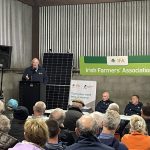
Seaweed has captured the farming industry’s imagination as a potential way to reduce emissions in dairy cows, but can it also improve milk quality and yield? Debbie James visited a Pembrokeshire dairy farm to find out more.
At South Astridge Farm, St Florence, William and Katy Fox produce milk from 322 British Friesians.
They established the business in 2022 after relocating from Hampshire where they had farmed a tenanted holding since 2009.
Last December they embarked on a Farming Connect ‘Our Farms’ study to look at the effects on milk production of feeding cows a seaweed supplement.
The interim results have now been published and have shown no impact on milk quality or yield and certainly no taste of seaweed!
But it is hoped that ammonia mitigation gains being explored in another Welsh trial could help farmers like the Foxes achieve environmental targets set by governments and their milk buyers.
Their autumn-calving herd calves over a nine-week block, producing an average annual yield of 7,115 litres at 4.3% butterfat and 3.43% protein.
The trial had involved cows split evenly into treatment and control groups, all at least 65 days in milk.
Cows were fed a flat rate of 2kg/day of concentrates in the parlour with the feed for the treatment group incorporating a feed additive, BioComplex.
“The cows were very happy to eat the treated feed and there were no reports of a taint in the milk,’’ said William.
The interim results were shared with farmers at a Farming Connect open day at South Astridge Farm.
Dr Natalie Meades, of the Institute of Biological, Environmental and Rural Sciences (IBERS) at Aberystwyth, the scientist who collated and analysed the results, said that to date there was no evidence that the product had enhanced milk production or quality.
But with ammonia mitigation already demonstrated in pigs and poultry and trials still on-going in cattle, she believed there were positives to be gained from this study.
“Unfortunately, we were not able to measure ammonia emissions within this project because it requires specialist equipment and controlled conditions that would be challenging to implement on a commercial farm,’’ said Dr Meades.
“However, if the BioComplex product is having the effect of reducing ammonia emissions from slurry, then there is a positive message here in terms of health and the environment.’’
A more comprehensive study underway at Aberystwyth University’s research farm, Trawsgoed, is looking at the effects of the supplement on ammonia emissions from slurry.
Ammonia is harmful to natural habitats and waterways, and to human health. In Wales, 85% of ammonia emissions are thought to come from farming.
Milk produced at South Astridge Farm is sold to First Milk through its regenerative farming programme.
As membership manager Peter Llewellin told farmers at the open day, reducing emissions is a key part of the co-operative’s target of reaching net zero by 2050.
Soil testing is part of this. Separately, South Astridge Farm was one of 25 Welsh farms sampled by Farming Connect for the Welsh Soils Project.
Other measures, including planting hedges and trees on supply farms, will also help businesses like First Milk achieve net zero ambitions.
Farming Connect Forestry Technical Officer Geraint Jones said the hedgerows on dairy farms are generally in good condition, especially those that practice rotational grazing, as frequently moving cows and youngstock to fresh grazing means they have little interest in nibbling at field boundaries.
But where hedgerows can often be improved is through ‘gapping up’ – filling gaps left by dead trees and depleted numbers of hedgerow stems.
In this situation, Mr Jones recommends taking the opportunity to introduce standard hedgerow trees.
“Introduce trees that are five or six foot high so that they protrude over the hedgerow canopy and will survive the competition from other trees,’’ he advised.
Planting in the gaps of hedges will strengthen the structure but lateral growth from plants either side of the gap will impede light levels needed for photosynthesis and growth.
Selecting hedgerow species that thrive in shade, such as holly, rowan and beech, are therefore a good choice for gapping up, Mr Jones said.
In Wales, grants for gapping up or restoring hedges are available through the Small Grants – Environment scheme.
You can now read the most important #news on #eDairyNews #Whatsapp channels!!!
🇺🇸 eDairy News INGLÊS: https://whatsapp.com/channel/0029VaKsjzGDTkJyIN6hcP1K

























